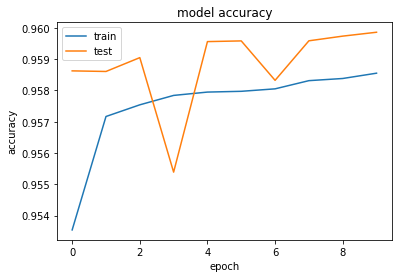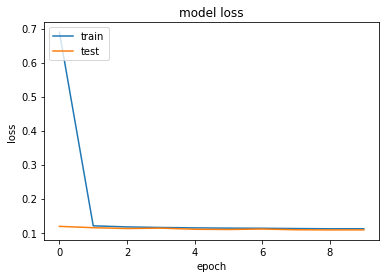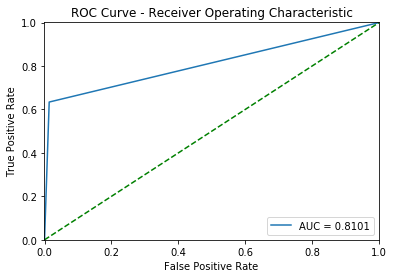Neural Network for Churn Prediction
- The project were written for kaggle Churn prediction competition
- WSDM - KKBox's Churn Prediction Challenge
- https://www.kaggle.com/c/kkbox-churn-prediction-challenge
from multiprocessing import Pool, cpu_count
import gc; gc.enable()
import xgboost as xgb
import pandas as pd
import numpy as np
from sklearn.preprocessing import StandardScaler,MinMaxScaler
from sklearn.svm import OneClassSVM
import collections
# For plotting
%matplotlib inline
import matplotlib.pyplot as plt
from sklearn.metrics import (confusion_matrix, precision_recall_curve, auc,
roc_curve, recall_score, classification_report, f1_score,
precision_recall_fscore_support)C:\Users\naomi\Anaconda2\lib\site-packages\sklearn\cross_validation.py:41: DeprecationWarning: This module was deprecated in version 0.18 in favor of the model_selection module into which all the refactored classes and functions are moved. Also note that the interface of the new CV iterators are different from that of this module. This module will be removed in 0.20.
"This module will be removed in 0.20.", DeprecationWarning)
Read Data
train.csv - the train set, containing the user ids and whether they have churned.
- msno: user id
- is_churn: This is the target variable. Churn is defined as whether the user did not continue the subscription within 30 days of expiration. is_churn = 1 means churn,is_churn = 0 means renewal.
train_v2.csv - same format as train.csv, refreshed 11/06/2017, contains the churn data for March, 2017.
train = pd.read_csv('train.csv')
train = pd.concat((train, pd.read_csv('train_v2.csv')),axis=0, ignore_index=True).reset_index(drop=True)
test = pd.read_csv('sample_submission_v2.csv')print (collections.Counter(train['is_churn']))Counter({0L: 1813090, 1L: 150801})
print test.shape
print train.shape(907471, 2)
(1963891, 2)
Transactions of users
transactions.csv - transactions of users up until 2/28/2017.
- msno: user id
- payment_method_id: payment method
- payment_plan_days: length of membership plan in days
- plan_list_price: in New Taiwan Dollar (NTD)
- actual_amount_paid: in New Taiwan Dollar (NTD)
- is_auto_renew
- transaction_date: format %Y%m%d
- membership_expire_date: format %Y%m%d
- is_cancel: whether or not the user canceled the membership in this transaction.
transactions_v2.csv - same format as transactions.csv, refreshed 11/06/2017, contains the transactions data until 3/31/2017.
To begin with, we will use the following features:
- trans_count - numberof user's transactions
- The last transaction detailes.
transactions = pd.read_csv('transactions.csv', usecols=['msno'])
transactions = pd.concat((transactions, pd.read_csv('transactions_v2.csv', usecols=['msno'])), axis=0, ignore_index=True).reset_index(drop=True)
transactions = pd.DataFrame(transactions['msno'].value_counts().reset_index())
transactions.columns = ['msno','trans_count']
train = pd.merge(train, transactions, how='left', on='msno')
test = pd.merge(test, transactions, how='left', on='msno')transactions = pd.read_csv('transactions_v2.csv')
transactions = transactions.sort_values(by=['transaction_date'], ascending=[False]).reset_index(drop=True)
transactions = transactions.drop_duplicates(subset=['msno'], keep='first')
train = pd.merge(train, transactions, how='left', on='msno')
test = pd.merge(test, transactions, how='left', on='msno')
transactions=[]User Logs - daily user logs describing listening behaviors of a user
user_logs.csv - Data collected until 2/28/2017.
- msno: user id
- date: format %Y%m%d
- num_25: # of songs played less than 25% of the song length
- num_50: # of songs played between 25% to 50% of the song length
- num_75: # of songs played between 50% to 75% of of the song length
- num_985: # of songs played between 75% to 98.5% of the song length
- num_100: # of songs played over 98.5% of the song length
- num_unq: # of unique songs played
- total_secs: total seconds played
user_logs_v2.csv - same format as user_logs.csv, refreshed 11/06/2017, contains the user logs data until 3/31/2017.
user_logs.csv is a big file, to big to be contained in memory. so to begin with,we willuse the following fetures:
- Number of user logs
- last user log detailes(from user_logs_v2.csv)
- Thanks to the1owl for thekernel "Regressing During Insomnia [0.21496]" https://www.kaggle.com/the1owl/regressing-during-insomnia-0-21496 for the code to read user logs features.
user_logs = pd.read_csv('user_logs_v2.csv', usecols=['msno'])
user_logs = pd.DataFrame(user_logs['msno'].value_counts().reset_index())
user_logs.columns = ['msno','logs_count']
train = pd.merge(train, user_logs, how='left', on='msno')
test = pd.merge(test, user_logs, how='left', on='msno')
user_logs = []; def transform_df(df):
df = pd.DataFrame(df)
df = df.sort_values(by=['date'], ascending=[False])
df = df.reset_index(drop=True)
df = df.drop_duplicates(subset=['msno'], keep='first')
return df
def transform_df2(df):
df = df.sort_values(by=['date'], ascending=[False])
df = df.reset_index(drop=True)
df = df.drop_duplicates(subset=['msno'], keep='first')
return dflast_user_logs = []
last_user_logs.append(transform_df(pd.read_csv('user_logs_v2.csv')))
last_user_logs = pd.concat(last_user_logs, axis=0, ignore_index=True).reset_index(drop=True)
last_user_logs = transform_df2(last_user_logs)
train = pd.merge(train, last_user_logs, how='left', on='msno')
test = pd.merge(test, last_user_logs, how='left', on='msno')last_user_logs=[]Members data - user information
members.csv - user information. Note that not every user in the dataset is available.
- msno
- city
- bd: age. Note: this column has outlier values ranging from -7000 to 2015, please use your judgement. gender
- registered_via: registration method *registration_init_time: format %Y%m%d
- expiration_date: format %Y%m%d, taken as a snapshot at which the member.csv is extracted. Not representing the actual churn behavior.
members_v3.csv - Refreshed 11/13/2017, replaces members.csv data with the expiration date data removed.
members = pd.read_csv('members_v3.csv')
train = pd.merge(train, members, how='left', on='msno')
test = pd.merge(test, members, how='left', on='msno')
members = []; print('members merge...') members merge...
gender = {'male':1, 'female':2}
train['gender'] = train['gender'].map(gender)
test['gender'] = test['gender'].map(gender)
train = train.fillna(0)
test = test.fillna(0)train = train.fillna(0)
test = test.fillna(0)
train.head()
<style scoped>
.dataframe tbody tr th:only-of-type {
vertical-align: middle;
}
</style>
.dataframe tbody tr th {
vertical-align: top;
}
.dataframe thead th {
text-align: right;
}
| msno | is_churn | trans_count | payment_method_id | payment_plan_days | plan_list_price | actual_amount_paid | is_auto_renew | transaction_date | membership_expire_date | ... | num_75 | num_985 | num_100 | num_unq | total_secs | city | bd | gender | registered_via | registration_init_time | |
|---|---|---|---|---|---|---|---|---|---|---|---|---|---|---|---|---|---|---|---|---|---|
| 0 | waLDQMmcOu2jLDaV1ddDkgCrB/jl6sD66Xzs0Vqax1Y= | 1 | 2 | 0.0 | 0.0 | 0.0 | 0.0 | 0.0 | 0.0 | 0.0 | ... | 0.0 | 0.0 | 0.0 | 0.0 | 0.000 | 18.0 | 36.0 | 2.0 | 9.0 | 20050406.0 |
| 1 | QA7uiXy8vIbUSPOkCf9RwQ3FsT8jVq2OxDr8zqa7bRQ= | 1 | 23 | 0.0 | 0.0 | 0.0 | 0.0 | 0.0 | 0.0 | 0.0 | ... | 0.0 | 0.0 | 1.0 | 1.0 | 281.600 | 10.0 | 38.0 | 1.0 | 9.0 | 20050407.0 |
| 2 | fGwBva6hikQmTJzrbz/2Ezjm5Cth5jZUNvXigKK2AFA= | 1 | 10 | 0.0 | 0.0 | 0.0 | 0.0 | 0.0 | 0.0 | 0.0 | ... | 0.0 | 0.0 | 0.0 | 0.0 | 0.000 | 11.0 | 27.0 | 2.0 | 9.0 | 20051016.0 |
| 3 | mT5V8rEpa+8wuqi6x0DoVd3H5icMKkE9Prt49UlmK+4= | 1 | 3 | 40.0 | 30.0 | 149.0 | 149.0 | 1.0 | 20170327.0 | 20170426.0 | ... | 5.0 | 4.0 | 19.0 | 51.0 | 6171.145 | 13.0 | 23.0 | 2.0 | 9.0 | 20051102.0 |
| 4 | XaPhtGLk/5UvvOYHcONTwsnH97P4eGECeq+BARGItRw= | 1 | 9 | 38.0 | 90.0 | 477.0 | 477.0 | 0.0 | 20170225.0 | 20170528.0 | ... | 0.0 | 2.0 | 11.0 | 12.0 | 3132.042 | 3.0 | 27.0 | 1.0 | 9.0 | 20051228.0 |
5 rows × 25 columns
#test.to_csv('test_xgb_0.14343.csv', index=False)
#train.to_csv('train_xgb_0.14343.csv', index=False)Simple Deep Learning: Feedforward Neural Network
# For Keras
from keras.models import Sequential
from keras.callbacks import ReduceLROnPlateau
from keras.callbacks import LambdaCallback
from keras.layers.normalization import BatchNormalization
from keras.optimizers import SGD
from keras.constraints import maxnorm
from keras.callbacks import EarlyStopping, ModelCheckpoint
from keras.utils import np_utils
from keras.models import Sequential
from keras.layers import Dense, Lambda
from keras.layers.core import Dropout
from keras import regularizers
from keras.models import Model, load_model
from keras.preprocessing import sequence
from keras.models import Sequential
from keras.layers import Dense, Dropout, Activation
from keras.layers import Embedding
from keras.layers import Conv1D, GlobalMaxPooling1D
from keras.datasets import imdb
from keras.models import Sequential
from keras.layers import Dense, Activation, MaxPooling1DUsing Theano backend.
Couldn't import dot_parser, loading of dot files will not be possible.
from sklearn.metrics import accuracy_score
from sklearn.metrics import confusion_matrix
from sklearn.metrics import classification_report
from sklearn.metrics import cohen_kappa_score
def print_stats(ytest, ypred):
print("Accuracy: {:.5f}, Cohen's Kappa Score: {:.5f}".format(
accuracy_score(ytest, ypred),
cohen_kappa_score(ytest, ypred, weights="quadratic")))
print("Confusion Matrix:")
print(confusion_matrix(ytest, ypred))
print("Classification Report:")
print(classification_report(ytest, ypred))def drow_roc_curve(y_true, y_pred):
fpr, tpr, thresholds = roc_curve(y_true, y_pred)
roc_auc = auc(fpr, tpr)
plt.title('ROC Curve - Receiver Operating Characteristic')
plt.plot(fpr, tpr, label='AUC = %0.4f'% roc_auc)
plt.legend(loc='lower right')
plt.plot([0,1],[0,1],'g--')
plt.xlim([-0.001, 1])
plt.ylim([0, 1.001])
plt.ylabel('True Positive Rate')
plt.xlabel('False Positive Rate')
plt.show();def drow_precision_recal(y_true, y_pred):
precision, recall, th = precision_recall_curve(y_true, y_pred)
plt.plot(recall, precision, 'b', label='Precision-Recall curve')
plt.title('Recall vs Precision')
plt.xlabel('Recall')
plt.ylabel('Precision')
plt.xlim([-0.01, 0.5])
plt.show()def drow_recall(y_true, y_pred):
precision, recall, th = precision_recall_curve(y_true, y_pred)
plt.plot(th, recall[1:], 'b', label='Threshold-Recall curve')
plt.title('Recall for different threshold values')
plt.xlabel('Threshold')
plt.ylabel('Recall')
plt.show()def drow_precision(y_true, y_pred):
precision, recall, th = precision_recall_curve(y_true, y_pred)
plt.plot(th, precision[1:], 'b', label='Threshold-Precision curve')
plt.title('Precision for different threshold values')
plt.xlabel('Threshold')
plt.ylabel('Precision')
plt.show()def drow_history_acc(history):
# list all data in history
print(history.history.keys())
# summarize history for accuracy
plt.plot(history.history['acc'])
plt.plot(history.history['val_acc'])
plt.title('model accuracy')
plt.ylabel('accuracy')
plt.xlabel('epoch')
plt.legend(['train', 'test'], loc='upper left')
plt.show()
def drow_history_loss(history):
# summarize history for loss
plt.plot(history.history['loss'])
plt.plot(history.history['val_loss'])
plt.title('model loss')
plt.ylabel('loss')
plt.xlabel('epoch')
plt.legend(['train', 'test'], loc='upper left')
plt.show()We have a lot of data in the train set, solets splitit totrainand validation set.
from sklearn.preprocessing import StandardScaler,MinMaxScaler
from sklearn.model_selection import train_test_split
from sklearn import metrics
XX_train, XX_val = train_test_split(train, test_size=0.2)cols = [c for c in train.columns if c not in ['is_churn','msno']]
X_train = StandardScaler().fit_transform(XX_train[cols])#.as_matrix()
y_train = XX_train['is_churn'].as_matrix()
X_val = StandardScaler().fit_transform(XX_val[cols])#.as_matrix()
y_val = XX_val['is_churn'].as_matrix()
X_test = StandardScaler().fit_transform(test[cols])#.as_matrix()lsize = 128model = Sequential()
model.add(Dense(lsize, input_dim=X_train.shape[1],activation='relu'))
model.add(BatchNormalization())
model.add(Dropout(rate=0.25))
model.add(Dense(int(lsize/2), activation='relu'))
model.add(BatchNormalization())
model.add(Dropout(rate=0.25))
model.add(Dense(int(lsize/4),kernel_regularizer=regularizers.l2(0.1), activation='relu'))
model.add(Dropout(rate=0.1))
model.add(Dense(1, activation='sigmoid'))
# Compile model
model.compile(loss='binary_crossentropy', optimizer='adadelta', metrics=['accuracy'])
model.summary()_________________________________________________________________
Layer (type) Output Shape Param #
=================================================================
dense_1 (Dense) (None, 128) 3072
_________________________________________________________________
batch_normalization_1 (Batch (None, 128) 512
_________________________________________________________________
dropout_1 (Dropout) (None, 128) 0
_________________________________________________________________
dense_2 (Dense) (None, 64) 8256
_________________________________________________________________
batch_normalization_2 (Batch (None, 64) 256
_________________________________________________________________
dropout_2 (Dropout) (None, 64) 0
_________________________________________________________________
dense_3 (Dense) (None, 32) 2080
_________________________________________________________________
dropout_3 (Dropout) (None, 32) 0
_________________________________________________________________
dense_4 (Dense) (None, 1) 33
=================================================================
Total params: 14,209
Trainable params: 13,825
Non-trainable params: 384
_________________________________________________________________
checkpointer = ModelCheckpoint(filepath="model_churn.h5",
verbose=0,
save_best_only=True)
reduce_lr = ReduceLROnPlateau(monitor='acc', factor=0.2,patience=1, min_lr=0.0001)
reduce_val_lr = ReduceLROnPlateau(monitor='val_acc', factor=0.4, patience=1, min_lr=0.0001)
es = EarlyStopping(monitor='loss', patience=3, verbose=1, mode='auto')
callbacks_list = [es, reduce_lr, reduce_val_lr, checkpointer]
# Fit the model
history = model.fit(X_train, y_train, epochs=10, batch_size=1026,#512,
validation_split=0.2, verbose=2,#data=(X_val, y_val)
callbacks=callbacks_list)Train on 1256889 samples, validate on 314223 samples
Epoch 1/10
- 38s - loss: 0.6891 - acc: 0.9535 - val_loss: 0.1185 - val_acc: 0.9586
Epoch 2/10
- 39s - loss: 0.1201 - acc: 0.9572 - val_loss: 0.1146 - val_acc: 0.9586
Epoch 3/10
- 39s - loss: 0.1169 - acc: 0.9575 - val_loss: 0.1122 - val_acc: 0.9590
Epoch 4/10
- 39s - loss: 0.1152 - acc: 0.9578 - val_loss: 0.1133 - val_acc: 0.9554
Epoch 5/10
- 39s - loss: 0.1141 - acc: 0.9579 - val_loss: 0.1100 - val_acc: 0.9596
Epoch 6/10
- 39s - loss: 0.1133 - acc: 0.9580 - val_loss: 0.1093 - val_acc: 0.9596
Epoch 7/10
- 40s - loss: 0.1130 - acc: 0.9581 - val_loss: 0.1107 - val_acc: 0.9583
Epoch 8/10
- 40s - loss: 0.1121 - acc: 0.9583 - val_loss: 0.1085 - val_acc: 0.9596
Epoch 9/10
- 40s - loss: 0.1114 - acc: 0.9584 - val_loss: 0.1081 - val_acc: 0.9597
Epoch 10/10
- 40s - loss: 0.1115 - acc: 0.9586 - val_loss: 0.1082 - val_acc: 0.9599
drow_history_acc(history)['acc', 'loss', 'val_acc', 'val_loss', 'lr']
drow_history_loss(history)predictions = model.predict(X_val)
y_pred = (predictions > 0.5)
print_stats(y_val, y_pred)Accuracy: 0.95904, Cohen's Kappa Score: 0.68224
Confusion Matrix:
[[357559 5055]
[ 11035 19130]]
Classification Report:
precision recall f1-score support
0 0.97 0.99 0.98 362614
1 0.79 0.63 0.70 30165
avg / total 0.96 0.96 0.96 392779
drow_roc_curve(y_val, y_pred)predictions = model.predict(X_test)test['is_churn'] = predictions.clip(0.+1e-15, 1-1e-15)
test[['msno','is_churn']].to_csv('submission_NN_std_10epoch.csv', index=False)

